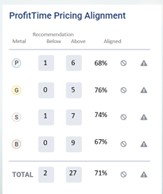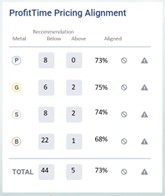A Means to Manage Your Gross Profit or Volume Preference in Used Vehicles
My recent post about dealer groups opting to go for used vehicle gross profit over volume prompted a question from several dealers—what if we do want to make the trade-off and make gross or volume our top priority?
It’s a great question because there certainly are times when a dealer’s  chief priority might be gross profit or volume, rather than a consistent balance between the two.
chief priority might be gross profit or volume, rather than a consistent balance between the two.
For example, a dealer who’s recently acquired a store they believe to be under-performing might be best served by gunning for volume over gross to establish (or re-establish) the rooftop as a local market leader in used vehicles. Or, there could be other circumstances, as noted in the recent Automotive News article that prompted my last post, where a dealer opts for gross profit due to difficulties acquiring sufficient inventory to advance their volume objectives and concerns about the strength of near-term retail demand.
Whatever the case, I have been cautioning dealers that if you do choose gross or volume as your primary used vehicle department objective, you’ll need a way to measure how well you/your team are working toward your objective in real-time and correct your present course if necessary. Without this real-time view, you’re always looking in the rearview mirror, evaluating your progress a month or more after the retail deals are already in the books and well past the time you can do anything about what’s already been done.
The limitations of a look-back approach to managing a dealership’s strategic objectives is a primary reason ProfitTime GPS offers a real-time view of a dealership’s current used vehicle pricing and how it aligns to the dealership’s strategy, whether it’s gross, volume or a balance of the two.
Here are a couple representative examples to illustrate my point. The examples might reflect how a dealer who sets gross profit as a chief priority, and another for a dealer who sets volume as their primary objective. (A quick refresher: ProfitTime GPS’s data science recommends retail price ranges for each vehicle, across Platinum, Gold, Silver and Bronze categories, to help dealers optimize their retail prices and capture the return on investment (ROI) or profit potential each vehicle offers.)
Gross-focused Dealer: This example shows a dealer who is gunning for gross profit, and likely doesn’t mind less volume to achieve it. You can see the dealer’s preference in the number of vehicles priced “above” ProfitTime GPS recommendations across every precious metal category.
gunning for gross profit, and likely doesn’t mind less volume to achieve it. You can see the dealer’s preference in the number of vehicles priced “above” ProfitTime GPS recommendations across every precious metal category.
If I was this dealer, I would want to take a closer look at the Silver and Bronze vehicles to see a) how far they are priced above ProfitTime GPS recommendations and b) how long the vehicles have been in the dealer’s inventory. It’s possible that the dealer’s over-arching emphasis on gross profit might actually be counter-productive with vehicles ProfitTime GPS designates as the dealer’s highest-risk investments.
Volume-focused Store: You can tell this dealer prefers volume over  gross by the number of vehicles in inventory priced “below” ProfitTime GPS recommendations across every precious metal category. If I were the dealer, this view would tell me that my managers/team are going for volume.
gross by the number of vehicles in inventory priced “below” ProfitTime GPS recommendations across every precious metal category. If I were the dealer, this view would tell me that my managers/team are going for volume.
But I might also want to take a closer look at two things. First, I’d examine how far we’ve priced vehicles below the recommendations, particularly with the Platinum and Gold vehicles, to see if there’s an opportunity to be less aggressive and still meet our goals for volume. Second, I’d want to look into the reasons someone priced a handful of vehicles in the Gold, Silver and Bronze categories above the recommendations—decisions that would naturally slow the turn on these vehicles.
The biggest benefit I’ve seen from dealers using this approach to manage their gross profit or volume objectives is the ability to see what’s happening in real-time and make adjustments as needed. When they do this, they’re able to consistently stay true to their preferred objective.
